Religious leaders hail 'moment of history' as Prince William makes first royal trip to most holy sites

Religious leaders have hailed a “moment of history” as the Duke of Cambridge made a moving tour through their holiest sites, becoming the first member of the Royal family to do so.
The Duke spent his final day of his Middle Eastern tour in Jerusalem, taking in the Mount of Olives, the Garden of Gethsemane, Temple Mount and the al-Aqsa mosque, the Western Wall and the Church of the Holy Sepulchre.
Given a tour of the sites by religious leaders, the Duke wore a kippah to the Western Wall, took his shoes off to visit the mosque and took bread and salt at the Russian Orthodox church.
At the wall, a sacred site for the Jewish people, he placed a written prayer on a folded piece of paper into one of the cracks and held his right hands on the ancient wall in quiet contemplation.
The British Chief Rabbi said the Duke’s visit was a “remarkable gesture of friendship”, at the end of a tour which has seen him undertake a finely balanced programme designed to respect both Israel and the Occupied Palestinian Territories.
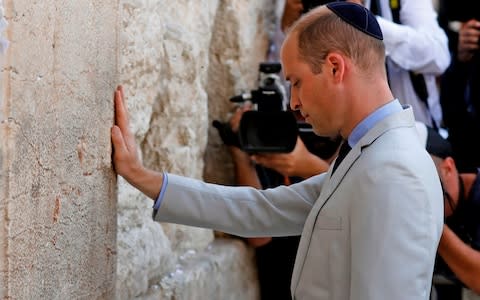
In his last few hours in Jerusalem, he turned his attentions not to politics but to religion, visiting some of the holiest sites Judaism, Islam and Christianity have to offer.
He began on the Mount of Olives, where he spent 20 minutes standing on a viewing point looking out over the sun-bathed Old City to marvel at the view.
Landmarks such as the Western Wall, Temple Mount and the Church of the Holy Sepulchre were pointed out with the help of Tareq, a guide from the British Embassy.
He said earlier that he would talk the prince through the major Biblical landmarks of the area and of events that have taken place on the Mount of Olives itself, including the last week of Jesus’ life.
The Mount has also been used as a Jewish cemetery for over 3,000 years and holds approximately 150,000 graves.

The Duke then moved to the Church of St Mary Magdelene, a golden-domed Russian Orthodox church on the Mount of Olives, in the Garden of Gethsamane.
Welcomed to the church by Archimandrite Roman, Father Roman, the head of the Russian Ecclesiastical Mission in Jerusalem, and Abbess Elizabeth, he took bread and salt before entering.
Once inside the church, the Duke laid flowers at the sarcophagus of St Elizabeth, where candles were lit and he paused for a moment of private reflection.
He then made his way down the church steps to his great-grandmother Princess Alice’s crypt, where he laid flowers picked from the garden of Philip Hall, Britain’s Consul General in Jerusalem.
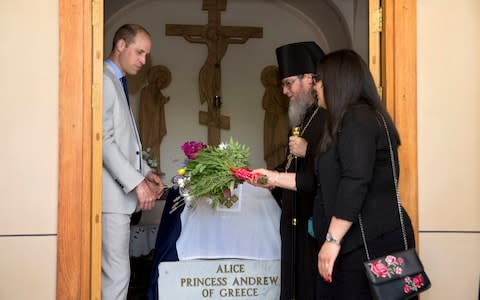
Father Roman then recited a “prayer for the reposal of Princess Alice’s soul”, while the Duke, eyes closed in prayer, bowed his head and prayed for several minutes.
Shown several photographs of Princess Alice and her family tree, he said: “It’s absolutely fascinating to hear about the family history.”
Father Roman told him: “Please send our best wishes to your grandfather and your father, and let them know that we are taking care of Princess Alice and we pray for her.”
“I will do,” said William. “Thank you so much.”
The pair also joked about the Duke of Edinburgh, Princess Alice’s son, as Father Roman said: “When I was showing him the family tree with the Russian links, I told the Prince that I’d read somewhere that someone once asked Prince Philip if he had ever been to Russia, and that he had said ‘they murdered half my bloody family, so maybe I’ll go, maybe not.’
“The Prince laughed and said: ‘He would say that’. The Duke left with an array of gifts, including small crosses and wooden Easter eggs for Princes George and Louis and Princess Charlotte “so they have a blessing from Jerusalem”.
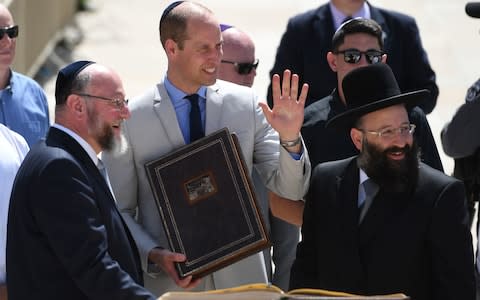
Father Roman said of the significance of the Duke's visit: “For us brothers and the sisterhood here, it is a great honour to have such a guest as Prince William here.”
Next on the packed itinerary was Temple Mount, considered exceptionally holy to both Jews and Muslims, situated in the shadow of the Mount of Olives.
The Duke of Cambridge was shown around the area by scholar Dr Mustafa Abu Sway, a professor of philosophy and Islamic studies at the city’s Al-Quds University who told the Duke about the historical significance of the site and why it is so revered by both religions.
Temple mount is also home to the Al-Aqsa Mosque, the third holiest site in Islam, as well as the gold-topped Dome of the Rock, one of the most recognized symbols of Jerusalem.
Prince William spent half an hour looking round the Dome of the Rock, which is the believed point of the Prophet Muhammad’s ascent to heaven in the seventh century.

The Temple Mount, known in Hebrew as Har Habayit and Haram al-Sharif or Noble Sanctuary in Islam, sits on elevated plaza above the Western Wall.
The Duke, wearing a cream suit, tie and blue shirt, arrived shortly after 9am and spent nearly an hour walking round the site, taking off his shoes out of respect before entering the mosque.
He appeared to listen intently to the professor and frequently looked around the magnificent building that has stood for hundreds of years.
The fourth site of the day, the Western Wall, saw the Duke watched by hundreds of members of the public, Jews making their own moving visit to their sacred site.
Greeted by Britain’s Chief Rabbi Ephraim Mirvis and the rabbi of the Western Wall, Shmuel Rabinovitch, he wore a kippah skull cap and placed a written prayer on a folded piece of paper into one of the cracks in the wall.

Holding his right hand against the ancient stones, he spent around a minute in quiet contemplation with his eyes shut.
A large crowd of Jewish worshippers watched him as he prayed, some singing and others shouting wellwishes including “We love you”.
The Chief Rabbi said afterwards: "Today we experienced a moment of history which will live long in the memory of Jews around the world.
“The Western Wall stands at the epicentre of our faith. To see the future Monarch come to pay his respects was a remarkable gesture of friendship and a sign of the Duke's regard for the sanctity of Jerusalem."
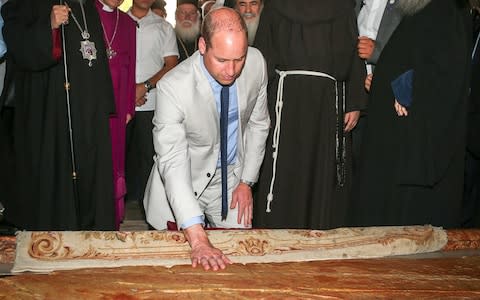
In his final visit of the tour, the Duke lit a candle at the spot where Jesus is believed to have been crucified as he visited the holiest site in the Christian world, the Church of the Holy Sepulchre.
The Church in the Old City stands above the supposed site of Jesus's crucifixion, burial and resurrection.
There, the Duke saw the Stone of the Anointing, where according to tradition Jesus's body was laid out for anointing by Joseph of Arimathea.
He was also shown the Holy Edicule, a shrine built where the body of Jesus was said to be buried. The Duke was shown round by the Greek Orthodox Patriarch of Jerusalem, Theophilos III.
Because the church is controlled by six different denominations, he was also joined by the Armenian Patriarch Nourhan Manougian and the Franciscan custodian of the church, Father Francesco Patton.
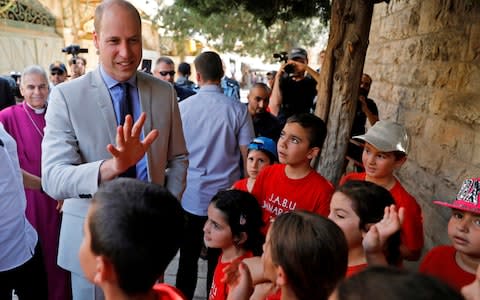
The Duke also met the Muslim who is the traditional custodian of the keys of the church, Adeeb Jawad Joudeh Al Husseini.
There have been so many disputes between the different Christian denominations that lay claim to the church that when Jerusalem was under the control of the Ottoman Empire the Sultan decreed that the keys should be looked after by a Muslim family.
The Duke’s arrival at the church was preceded by an escort of monks beating the ground with sticks.
At the Stone of the Anointing, one of the artefacts of which the authenticity is most strongly disputed, the Duke knelt down to lay a hand on the stone.

 Yahoo News
Yahoo News 
